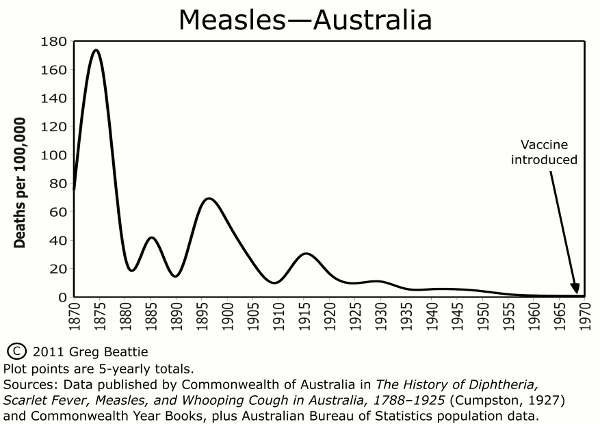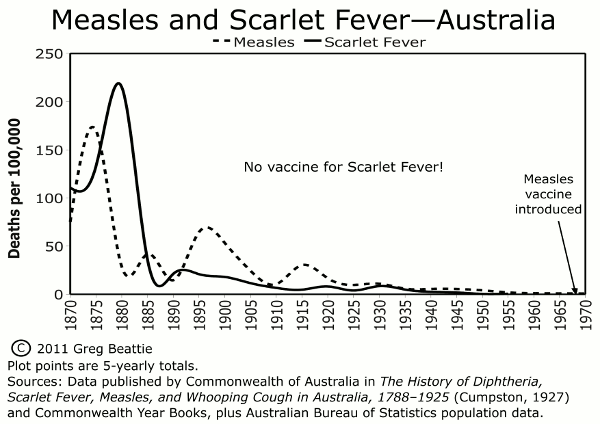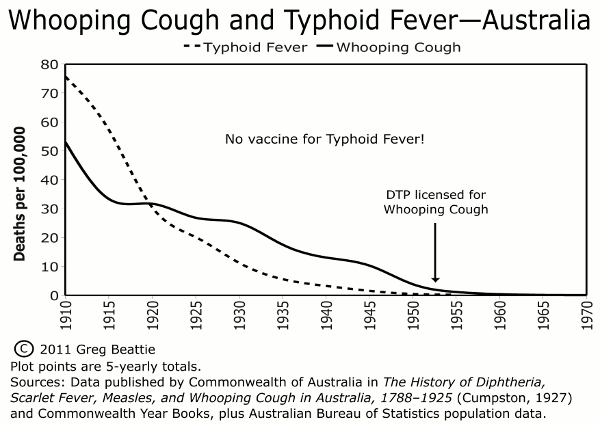Doctors are not above question-vaccines have NOT saved millions of lives!
As stated on the AVN's Website, we will be critiquing the propaganda booklet just published by the government and Australian Medical Association (AMA)-funded Australian Academy of Sciences.
Many of the dramatic statements made in this booklet are either verifiably incorrect or unscientific. Despite the long list of medical references at the end of the publication, many of the claims made aren't in any way scientific and one of the first and most egregious comes directly from the introduction:
Immunisation has transformed human health by preventing the deaths of hundreds of millions of people.
As Greg Beattie, Author of Vaccination: A Parent's Dilemma and Fooling Ourselves on the Fundamental Value of Vaccines has said, this statement is the 'mantra' of vaccination. The belief that vaccinations have saved millions of lives and without vaccination, we would see a return to high death levels appears to be baseless. Medical science wants to take credit for a decline in mortality which took place - in most cases - well before vaccines appeared on the scene. Claiming that vaccination was the reason for this decline is not just baseless, it's fraudulent.
If vaccinations saved lives, we would expect to see an increasing rate of decline in death rates after their introduction. But there IS no increase and in fact, the deaths from infectious diseases declined whether there was a vaccine or not. See the graphs below - all of which were reproduced with the kind permission of Greg Beattie.
Measles and Scarlet Fever
Measles vaccines were first introduced into Australia in 1970. At that time, the death rate had declined from its high of almost 180 per 100,000 head of population / five years, to nearly to zero / five years in 1970. This decline took place over the 100 years BEFORE the introduction of a vaccine. So did the introduction of the measles vaccine save any lives at all? According to the government's own data, there appears to be no evidence to indicate that it did.

Now, let's look at a disease for which there was never a vaccine in use such as scarlet fever. The graph below combines the information on deaths from measles (the dotted line) with deaths from scarlet fever (the solid line). Scarlet fever killed more people in Australia than measles, so there is no doubt that it was a deadly disease at a time when hygiene, nutrition and living conditions left a bit to be desired. But unlike measles, there was never a vaccine for scarlet fever (there were several vaccine candidates but they killed more people then they helped so they were never released in Australia). Scarlet fever is a bacterial disease so antibiotics can be used to treat it, but antibiotics were not widely available until the late 1940s - early 1950s by which time, deaths from scarlet fever were virtually nonexistent. Neither vaccinations nor antibiotics had anything to do with the decline in deaths from either measles or scarlet fever.

Now, let's take a look at whooping cough. This situation is slightly more difficult because there was an early vaccine that was used in the 1940s in Australia though it did not have widespread acceptance until 1953 when it was combined with diphtheria and tetanus vaccines as part of the DPT. As you can see from the graph below, the deaths from whooping cough (solid line) were not quite down to zero in the 1940s at the time of early vaccination but it had certainly shown a huge decline before that period of time. Again, this graph compares the deaths from whooping cough with another deadly disease for which we never used vaccines - typhoid fever.

Typhoid fever (dotted line) was killing almost 80 per 100,000 head of population every 5 years in the early part of last century. Without any vaccination whatsoever, deaths from typhoid declined in line with deaths from whooping cough. In fact, the decline in deaths from whooping cough seemed to plateau when we first started to use the vaccine while typhoid's decline was steady and consistent throughout that period.
Regardless of your interpretation of these differences, it seems obvious that vaccination had nothing to do with the decline in deaths from whooping cough and anyone who says they did is not basing their statement on facts or science.
Dr Cory needs to provide her evidence
Dr Suzanne Cory, President of the Australian Academy of Science, has made a statement from her esteemed position. She has said that vaccinations have prevented the deaths of hundreds of millions of people, but according to the available evidence, vaccines may have played little to no role in reducing mortality from infectious disease.
I call on Dr Cory to publicly present any proof to support her assertions. She's made a grand claim which is, on the surface and according to all the available data, completely absurd. We, the healthcare consumers of Australia, demand that she provide evidence to back up these claims..
Alternatively, I am very happy to meet her in a public venue where both of us can present our information so that the parents of Australia can decide for themselves whose side is evidence-based and whose is not.



